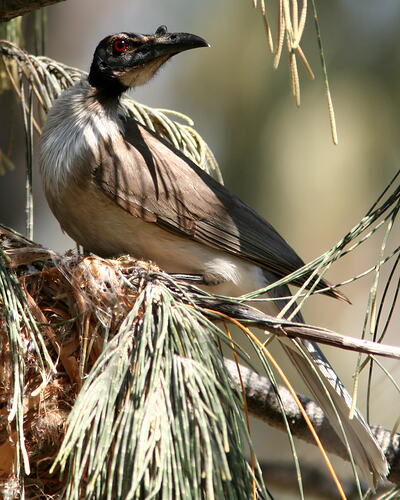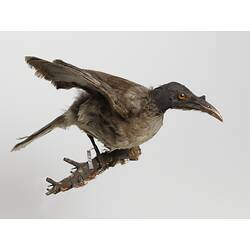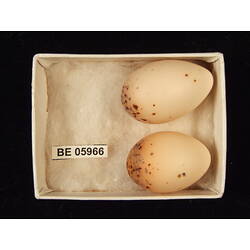General Description
A large bird with a distinctive naked black head and a strong bill with a prominent casque (bump) at the base. The upper parts are dark brown to grey; the underbody is off-white, with silver-white feathers around the throat and upper breast; and the tail has a white tip. It is a member of the honeyeater family. Body size up to 35 cm. Call a noisy, harsh and discordant deep honking sound: 'tobacco' or 'four o'clock'. Also a sharp 'owk owk'.
Biology
Partial migrant in south of range, moving north in autumn and south in late winter. Its diet consists of nectar, fruit, insects and other invertebrates and sometimes eggs or baby birds. It spends most of its time feeding high up in the trees, only coming down to the ground occasionally. Often feeds in noisy flocks, and with other honeyeaters. They form long-term pairs, with both parents defending the nest and surrounds. The female builds the large, deep cup-shaped nest from bark and grass, bound with spider webs, slinging it in a tree-fork. She alone incubates the eggs, but both parents feed the young, for up to three weeks after fledging.
Distribution
Eastern Australia
Habitat
Dry forests and eucalypt woodlands, as well as coastal scrub, heathlands and around wetlands and wet forests.
More Information
-
Animal Type
-
Animal SubType
-
Brief Id
Large bird, black head, strong bill with prominent bump, dark brown grey above, white underneath.
-
Colours
Black, Brown, Grey, White
-
Maximum Size
35 cm
-
Habitats
-
Endemicity
-
Commercial
No
-
Conservation Statuses
CITES: Not listed, FFG Threatened List: Not listed, EPBC Act 1999: Not listed, IUCN Red List: Least Concern
-
Taxon Name
-
Common Name
Noisy Friarbird
-
Kingdom
-
Phylum
-
Subphylum
-
Class
-
Order
-
Family
-
Genus
-
Species Name
corniculatus


